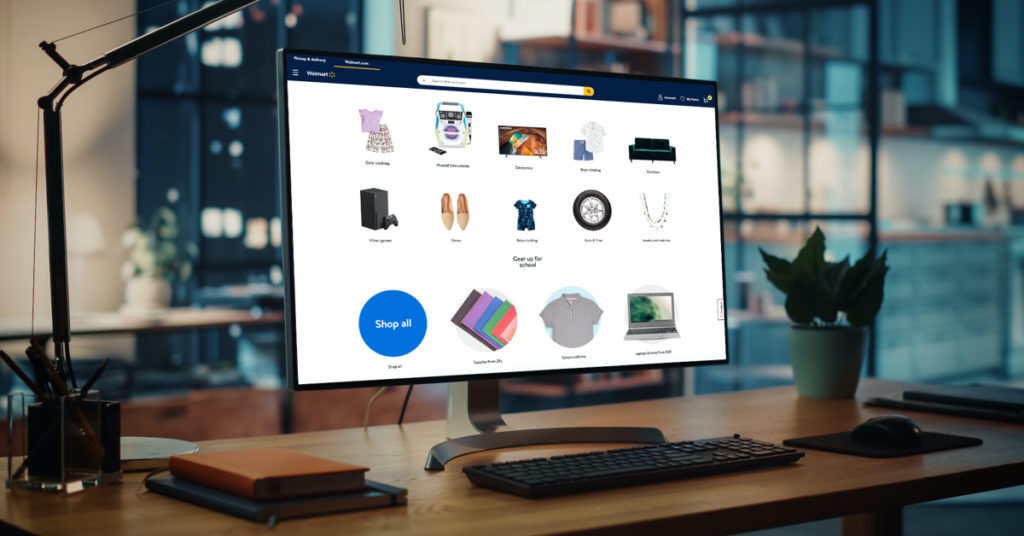If you sell product through Walmart, you’re already taking advantage of America’s largest physical retailer and second-largest online retailer.
Huge reach equals huge opportunity. But you’ll only achieve an impressive reach if you advertise appropriately.
Setting up a sponsored product campaign can help you get noticed, increase sales, and control costs.
What better way to learn the best tips and tricks than from Walmart executives?
Lex Josephs, VP of Ad Sales & Ad Tech Partnerships at Walmart Connect teamed up with Teikametrics Senior Director of Sales Jason Magee to bring you the essential advertising playbook for Walmart sellers.
The 4 types of high-traffic ad placements
Walmart’s sponsored product campaigns consist of four types of high-traffic placements where your product ads may appear.
Each placement type unlocks unique benefits and can drive customers to your product page.
1. Search in Grid: These ads highlight your product on the first page of results when customers search relevant keywords.
2. Product Carousel: These ads show your product on results pages and on item pages for similar products. It’s a great way to target customers based on browsing behavior.
3. Buy Box: This is a premium placement that targets customers as they make their final buying decision. It’s a high visibility placement on item pages for similar products.
4. Pickup and Delivery: This is a featured item carousel on the homepage for pickup and delivery. It’s hyper-local and great for new products or when you’re trying to reach new customers.
The 4 reports that measure campaign performance
Walmart has campaign reporting tools that let you measure many different metrics.
There are four different types of on-demand reports, all of which give you deeper insights into how your ads are performing.
1. Item keyword performance report: This report indicates which keywords your advertised items are being served against, and how well the advertised items are performing for those keywords. It can also help identify keywords to use in automatic or manual campaigns.
2. Keyword performance report: This report indicates which keywords you advertised items are being served against, and can help you optimize against your keyword bids.
3. Placement performance report: This report allows you to view key metrics like CTR, conversion, ROAS, and more for your specific keyword campaigns. Use it to improve campaigns using the bid multiplier to optimize placements based on reporting.
4. Item health report: This report helps you to check your inventory status. It provides a streamlined view of your advertised items including availability, Buy Box win rate, etc. If you notice your campaign is struggling to spend, this is a way to confirm whether items are in stock.
With each of these reporting tools you can optimize your ad campaigns thanks to valuable data and suggestions.
Set product goals and track the right metrics
Now that we’ve outlined the types of ad placements and how you can measure success, it’s time to consider an important question: What does success mean to you?
Is it hitting big sales numbers? Driving major brand recognition?
Lex said first the first step to a successful ad campaign is determining what your goals are and then keeping an eye on the metrics that will best tell you if you are succeeding.
“With performance and sales, the key metrics you would be focusing your campaign around would be return on ad spend, known as ROAS, and sales revenue,” Lex said.
If you’re looking to increase brand awareness, then it’s all about having as many eyes on your product as possible. “The metrics that your campaign is focused on are impressions, clicks, and ad spend,” Lex said.
That’s an important category for larger brands with a lot of SKUs, because it helps you to capture more brand loyal customers.
Another goal you can have is to grow your SKUs. It requires the most patience, but it can help grow your brand overall and have organic benefits.
If your SKUs are low on reviews and ratings, this is where you want to put your efforts.
“With so much competition out there, it’s all about getting customers to interact with your SKUs and being in it for the long haul,” Lex said. “Key metrics include clicks, units sold, and conversion rate.”
You want to focus on SKUs that are new to walmart.com or those with low performance.
Regardless of which goal you choose, never just set your advertisement plan and then forget it. You should continually optimize your strategy using tracking and reporting tools.
Figure out your organic performance
One of the most important things to remember is that each SKU needs its own approach.
If an item is new, a bestseller, or a low performer, each of those things needs a different strategy. You don’t want to pour ad dollars into an item that doesn’t really need it.
“You need to take a deep accounting of where your products rank organically on top search terms,” Jason said.
Walmart only shows a SKU once per results page. That means if your products are doing well organically, there won’t also be an ad for it on that page.
“The way Walmart’s built it is if you’re going to advertise, that ad placement is only going to better where you rank organically,” Jason said. “So you have to be very strategic.”
If you’re already ranking high for your main keywords, you may not need to run ads for that product.
Prioritize quick fulfillment
To make sure your ads pay off in the highest number of conversions, make sure you offer fast shipping.
“Not only does Walmart want to make sure that they have good caliber sellers that can fulfill on time,” Jason said. “Customers are super sensitive to how you deliver, especially how quickly you can do so.”
The difference between slow and two-day shipping conversion rates is very high.
“If you’re using Walmart fulfillment service or you have two-day shipping, or if you’re 1P or Walmart’s pick packing and shipping your items, having that two-day shipping time can increase your conversion rates an average of 41.2%,” Jason said.
Having great content and great ads will only get you so far if you don’t also nail fulfillment.
“So if you think that you’re putting your best foot forward and you don’t have delivery expedited and really dialed in, you’re missing massive amounts of sales and exposure,” said Jason.
Experiment with bids to increase profit
Once you have all of the above worked out and have clear strategy, you can start to experiment to increase your profit.
Walmart has a First Bid Auction for ads, which means the highest price wins the bid.
“First Price Auction means that you need to make sure that you’re testing out higher bids, but just because you’re sitting at the top of the win with a top bid doesn’t mean you can’t be winning at a lower price point,” Jason said.
You want to maximize efficiency and profitability by combining automatic and manual campaigns.
“Automatic and manual campaigns have different advertising inventory,” Jason said.
“Manual campaigns, you have Search in Grid and carousel. On automatic, you have Search in Grid, carousel, category pages, and Buy Box pages.”
Jason recommends always having automatic campaigns running because they give you exposure in more placements.
If you follow the playbook above and think through the strategy for each product, you’ll have everything you need to win on Walmart.com.





